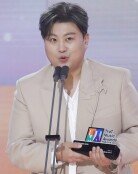Number of Theses Published in Worldwide Science Journals Jumps 10 Times in Five Years
Number of Theses Published in Worldwide Science Journals Jumps 10 Times in Five Years
Posted April. 11, 2005 23:30,
The First World-wide Discovery of an Anti-aging Substance. (Professor Paik Yung-gi at Yonsei University, February edition of Nature)
Cancer Suppressing Protein Regulator p18 Identified. (Professor Kim Seong-hoon at Seoul National University, January edition of Cell)
First Identification of How the Killer Cells Which Take a Key Role in the Immune System are Formed. (Dr. Choi In-pyo at Korea Research Institute of Bioscience and Biotechnology, February edition of Immunity)
High-tech Storage Method Developed for Hydrogen, a Future Energy Source. (Professor Lee Heun at the Korea Advanced Institute of Science and Technology, April edition of Nature)
Coming into this year, Koreas scientific accomplishments are consecutively being published in worldwide major science journals.
The world is focusing on Koreas rapid progress in the biotechnology (BT) and information technology (IT) fields.
Nature Biotechnology, a science journal, featured Korea in their special supplement Health and Biotechnology Innovations of Developing Countries, published at the end of last year.
This supplement introduced the fact that with the introduction of LG Life Sciences hepatitis B vaccine in 1991, Korea has steadily developed new remedies, and with the first successful extraction of stem cells from cloned human embryos by a Seoul National University team lead by Professor Hwang Woo-suk, it judged that Korea will lead the future medical market.
In addition, some 40 pharmaceutical companies are securing about 130 new medicines already in their first and second steps of clinical testing, and they are forecasting that it will not be long until a great number of new remedies passing the third step will tumble out into the market.
At the American Chemical Society meeting held last month on March 14, Professor Diana Hicks at Georgia Tech stated, The research accomplishments of Asian countries, including South Korea, China and Japan, are pressuring the U.S.
The attention of advanced countries to Koreas science and technology is unprecedented, and it seems to show that there is an underlying wariness to late-start pursuers.
The research accomplishments shown in the Korean BT field are remarkable. The number of theses published in major science journals has made great strides, jumping by more than 10 times from 78 theses in 1998 to 940 (2003) in just five years.
Along with the growth in Samsung Electronics and LG Electronics, applied science is continuing its rapid advance in the IT field.
The Korea Institute of Science and Technology Evaluation and Planning (KISTEP) announced in their evaluation for five major technologies, IT, BT, base industry technology, environment and energy technology and space technology, that the IT field has caught up to 71.6 percent of advanced countries, and the technical gap is about three to four years.
Digital broadcasting, mobile multimedia contents and home network technologies have followed to come within 80 percent of advanced country levels, closing a large portion of the gap in two years.
The number of registered Korean patents in the entire world was 34,675 in 2001, up from 11,683 in 1994.
The number of theses published in worldwide science journals registered 2,962 in 1993 in the Science Citation Index (SCI), but increased to 18,635 in 2003, jumping from 28 to 14 in the worldwide rankings.







